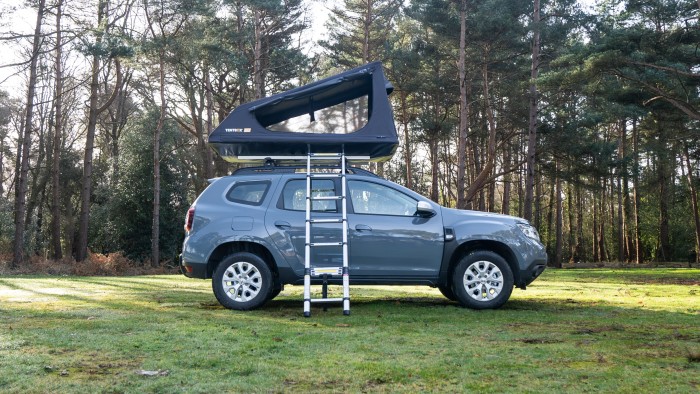Unlock the Editor’s Digest for free
Roula Khalaf, Editor of the FT, selects her favourite stories in this weekly newsletter.
Elevator pitch
The idea of pitching a tent on the roof of your car has been knocking around since the 1950s, but has only latterly begun to shrug off its eccentricity. In the UK, at least, that’s largely down to Southampton-based TentBox and its founders, brothers Ollie and Neill Shurville. “About 10 years ago we were planning a road trip and trying to work out the best way of doing it,” says Neill, regarding their moment of entrepreneurial inspiration. “We found a guy on Gumtree who agreed to install a roof tent on Ollie’s VW Passat estate, and at every campsite we went to we had crowds of people asking us about it.”
Once you’ve come to terms with seeing a tent on top of a car, its advantages become clear: you don’t have to find a spot to pitch, it’s quick to set up (60 seconds, in this case) and feels safer, somehow; the comparisons to a treehouse feel wholly appropriate. Also, the obvious questions are easily answered: how do I get up there (there’s a telescopic ladder), will it support the weight of two people (yes) and will it really fit on my car (almost certainly).

The Go, TentBox’s newest model, is the result of an intensive design process focused on reducing its weight to allow it to be more easily erected and manoeuvred while keeping the structure strong. The result is a two-person, double bed-sized, hammock-style tent weighing just 33kg; it sits on the roof bars of your car (no need to remove it when you are in transit), folds up and down with minimal effort, shields you from the elements and feels like an exclusive dormer window to the outside world.
The very first set-up (best done before you travel, for obvious reasons) involves assembling the aluminium tube frame and fixing it to the fabric; you’ll find that as easy (or as difficult) as a piece of flat-pack furniture, but it shouldn’t take more than an hour. Thereafter it’s as easy to take on and off as a roof box – needless to say, it’ll bring you far greater pleasure.
Shooting star
Drones are generally flown for the pleasure of piloting them, but HoverAir’s are action cams, taking off from the palm of your hand and hovering nearby, tracking your movements and taking snaps and videos until you beckon them in to land. (At which point you can fold them in half and pop them in a bag.)

The X1 ProMax is the beefed-up successor to last year’s X1: still very light (192g) but with a better camera and a longer range. It’s a brilliantly conceived tool for filmmakers, with its dolly mode tracking you perfectly, moving backwards as you walk towards it. The app’s ability to record audio on your phone and combine it with the video (while filtering out the buzz of the drone) is a masterstroke.
When the Brompton gets tough

The classic 16in-wheel Brompton (now 45 years old!) has always been a super-portable choice for commuters, but it’s only meant for city-based scooting. The 20in wheels and discreet redesign of the new G Line open up all-terrain possibilities while giving the rider more stability and greater confidence; if you close your eyes while riding it (obviously don’t do this), it feels like a full-size bike, while retaining Brompton’s manoeuvrability and accessibility. Naturally, bigger means heavier, so when it’s folded you’ll probably push it about like a wheelie suitcase rather than carrying it, but it’s still super-compact. The electric version almost invisibly integrates the motor and extra cabling – you’d never know.
An open and shut case

Any new device with a folding screen inevitably prompts the query of how visible the crease is. Google has done a good job with its new flagship foldable (it’s pretty much invisible), but it’s really the wrong question to ask. Extraordinarily slim and light for what’s effectively a phone and tablet (just 30g heavier and 2.25mm thicker than the iPhone 16 Pro Max), the Pixel 9 Pro Fold gives huge screen real estate, side-by-side app multitasking and battery life that puts a non-foldable to shame. Pixel-exclusive features include a souped-up weather app, brilliant screenshot organisation and call screening, where you can direct callers to announce themselves and, if necessary, be fobbed off by a Google-voiced secretary.
Welcome to the top table

When you’re in the countryside or on the beach, using portable solar panels to recharge your devices is very sensible, but having them double up as a table is downright clever. This knee-high, 80cm by 63cm table takes less than a minute to unfold and erect; attached to the underside you’ll find a small junction box with two USB-A ports, a USB-C port and a 18V DC out with myriad connectors for hooking up portable power stations. So, it doesn’t store power, but certainly puts it out, juicing your devices as fast as the sun is bright. It comes with two pockets on each side to pop your phones into, and its own bag for carrying it to and fro.

